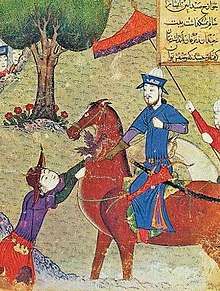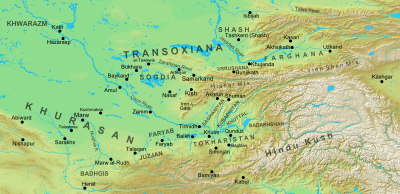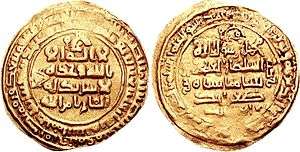Tughril
Tughril Bey (Persian: السلطان رکنالدنيا والدين ابوطالب طغرلبک محمد بن میکائیل بن سلجوق یمین امیرالمومنین;[1] full name: Rukn al-Dunya wa al-Din Abu Talib Muhammad Toghrul-Beg ibn Mikail, also spelled Toghrul I, Tugril, Toghril, Tugrul or Toghrïl Beg; 990 – September 4, 1063) was the Turkoman[2][3] founder of the Seljuk Empire, ruling from 1037 to 1063. Tughril united the Turkmen warriors of the Great Eurasian Steppes into a confederacy of tribes, who traced their ancestry to a single ancestor named Seljuq, and led them in conquest of eastern Iran. He would later establish the Seljuq Sultanate after conquering Persia and retaking the Abbasid capital of Baghdad from the Buyid dynasty in 1055. Tughril relegated the Abbasid Caliphs to state figureheads and took command of the caliphate's armies in military offensives against the Byzantine Empire and the Fatimid Caliphate in an effort to expand his empire's borders and unite the Islamic world.
| Tughril | |||||
|---|---|---|---|---|---|
| Bey | |||||
 | |||||
| Sultan of the Great Seljuq Empire | |||||
| Reign | 1037 – 4 September 1063 | ||||
| Predecessor | Empire established | ||||
| Successor | Alp Arslan | ||||
| Born | 990 | ||||
| Died | 4 September 1063 (aged 73) | ||||
| Spouse | Aka, daughter of Yusuf Qadir-Khan Altun Jan Khatun Seyyedeh Fatima | ||||
| Issue | None | ||||
| |||||
| House | House of Seljuq | ||||
| Father | Mikail of Kınık tribe | ||||
| Religion | Sunni Islam | ||||
Early life

Tughril was the son of Mikail Beg ibn Seljuq; on the death of his father, Tughril and his brother Chaghri were raised by their grandfather Seljuk, who had other sons named Musa Yabghu and Arslan Isra'il, whom Tughril would later accompany into the Iranian plateau during his later life. Tughril ascended to power ca. 1016.
In the 1020s, Tughril and his other relatives were serving the Kara-Khanids of Bukhara. In 1026, the Kara-Khanids were driven out of Bukhara by the Ghaznavid Sultan Mahmud of Ghazni. This defeat made Arslan Isra'il flee to a place near Sarakhs, where he asked Mahmud for permission to settle in the area in return for military aid. Mahmud, however, had Arslan Isra'il put in prison, where the latter soon died. Meanwhile, Tughril and Chaghri remained loyal to their Kara-Khanid overlords. Although in 1029 they had some disputes with the Kara-Khanids, they continued to support them, and still continued to participate in the Kara-Khanid wars against the Ghaznavids; in 1032, they were present at the Battle of Dabusiyya.
After the Kara-Khanid ruler Ali-Tegin's death, however, the Seljuqs changed their allegiance to the ruler of Khwarazm, Harun,[4] but were in 1035 repelled by the Oghuz ruler Shah Malik. The Seljuqs then went to the same place which Arslan Isra'il had gone to, and asked the son of Mahmud, Mas'ud I, for asylum. Mas'ud, however, considered the nomadic Turks a dangerous threat and sent an army under commander-in-chief Begtoghdi. The army was shortly defeated by the Seljuqs, who forced Mas'ud to cede Nasa, Farava and Dihistan in return for Seljuq recognition of Ghaznavid authority and protection of the region from other Turkic tribes.[5]
In 1037, the Seljuqs managed to force the Ghaznavids to cede them Sarakhs, Abivard and Marw. The Seljuqs then slowly began to subdue the cities of Khorasan, and when they captured Nishapur, Tughril proclaimed himself as the Sultan of Khorasan.
Reign

Mas'ud, after having returned to Khorasan, expelled the Seljuqs from Herat and Nishapur. He soon marched towards Merv to completely remove the Seljuq threat from Khorasan. His army included 50,000 men and 12 to 60 war elephants.
A battle shortly took place near Merv, known as the Battle of Dandanaqan, where the army of Mas'ud was defeated by a much smaller army under Tughril, his brother Chaghri Beg, and the Kakuyid prince Faramurz. Mas'ud thus permanently lost control of all of western Khorasan. This victory marked the foundation of the Seljuk Empire, which was now rapidly expanding towards West.
Tughril then installed Chagri as the governor of Khorasan and prevented a Ghaznavid reconquest, then moved on to the conquest of the Iranian plateau in 1040-1044; In 1041/2, Tughril conquered Tabaristan and Gurgan, and appointed a certain Mardavij ibn Bishui as the governor of the region. In 1042/3, he conquered Ray and Qazvin, and at the same his suzerainty was acknowledged by the Justanid ruler of Dailam.[6] The Sallarid ruler of Shamiran also shortly acknowledged the suzerainty of Tughril.[7]
By 1054 his forces were contending in Anatolia with the Byzantines and in 1055 he was commissioned by the Abbasid Caliph Al-Qa'im to recapture Baghdad from the Buyids.[8] A revolt by Turcoman forces under his foster brother İbrahim Yinal, Buyid forces and an uprising against the Seljuqs led to the loss of the city to the Fatimids Caliph in 1058. Two years later Tughril crushed the rebellion, personally strangling İbrahim with his bowstring and entered Baghdad. He then married the daughter of the Abbasid Caliph near the city of Tabriz.[9]
Succession
He died childless in the city of Rey in modern Iran and was succeeded by his nephew Suleiman which was contested by Alp Arslan, both of them sons of his brother Chaghri.[10] His cousin Kutalmish who had both been a vital part of his campaigns and later a supporter of Inal's rebellion also put forth a claim. Alp Arslan defeated Kutalmish for the throne and succeeded on April 27, 1064.
Legacy
Sultan Tughril was undoubtedly a military genius. Though his military campaigns inflicted serious damage on the productive forces of many conquered states, they paved the way for the establishment of the first powerful medieval empire of the Turks that linked "the East and the West"[11]. The formation of a vast empire objectively led to important changes in socio-economic, political and cultural life. The role of the landowning aristocracy markedly increased. Gradually, a new apparatus of state administration and the imperial system of civil and military administration took shape.
Tughril's conquests had an impact on the lives of not only the people of annexed states, but also the nomads themselves, who participated in the establishment of the new state. Noticeable changes in the life of the Oguz-Turkmen tribes occurred as they settled in Khorasan, Iran, Iraq, Syria, Transcaucasia and Asia Minor[12]. The transition of compact groups of nomads to a semi-settled and sedentary life and agriculture took place. The old tribal ties broke up; feudal relations received a new incentive for further development, although remnants of archaic institutions remained for a long time. The Seljuk nobility began to gradually merge with the feudal aristocracy of the conquered lands.
References
- Rāvandī, Muḥammad. Rāḥat al-ṣudūr va āyat al-surūr dar tārīkh-i āl-i saljūq. Tehran: Intishārāt-i Asāṭīr. p. 85. ISBN 9643313662.
- Grousset, Rene, The Empire of the Steppes, (Rutgers University Press, 1991), 161,164; "It is to be noted that the Seljuks, those Turkomans who became sultans of Persia..."
- Fleet, Kate (2009). The Cambridge History of Turkey: Byzantium to Turkey, 1071–1453: Volume 1 (PDF). Cambridge University Press. p. 1."The defeat in August 1071 of the Byzantine emperor Romanos Diogenes by the Turkomans at the battle of Malazgirt (Manzikert) is taken as a turning point in the history of Anatolia and the Byzantine Empire.
- Bosworth 1968, p. 19.
- Bosworth 1975, p. 192.
- Madelung 1975, p. 224.
- Madelung 1975, p. 225.
- Van Donzel 1994, p. 457.
- Minorsky 2000, p. 42.
- Canby, Sheila R.; Beyazit, Deniz; Rugiadi, Martina; Peacock, A. C. S. (April 27, 2016). Court and Cosmos: The Great Age of the Seljuqs. Metropolitan Museum of Art. ISBN 9781588395894.
- Alaev, L.B.; Ashrafyan, K.Z. (1994). History of the East. Vol. 2. The East in the Middle Ages. Eastern Literature, Russian Academy of Sciences. ISBN 5-02-018102-1.
- Alaev, L.B.; Ashrafyan, K.Z. (1994). History of the East. Vol. 2. The East in the Middle Ages. Eastern Literature, Russian Academy of Sciences. ISBN 5-02-018102-1.
Sources
- Bosworth, C. E. (1975). "The early Ghaznavids". In Frye, R. N. (ed.). The Cambridge History of Iran, Volume 4: From the Arab Invasion to the Saljuqs. Cambridge: Cambridge University Press. pp. 162–198. ISBN 0-521-20093-8.CS1 maint: ref=harv (link)
- Bosworth, C. E. (1968). "The Political and Dynastic History of the Iranian World (A.D. 1000–1217)". In Frye, R. N. (ed.). The Cambridge History of Iran, Volume 5: The Saljuq and Mongol periods. Cambridge: Cambridge University Press. pp. 1–202. ISBN 0-521-06936-X.CS1 maint: ref=harv (link)
- Bosworth, C. E. (1975). "Iran under the Buyids". In Frye, R. N. (ed.). The Cambridge History of Iran, Volume 4: From the Arab Invasion to the Saljuqs. Cambridge: Cambridge University Press. pp. 250–305. ISBN 0-521-20093-8.CS1 maint: ref=harv (link)
- Madelung, W. (1975). "The Minor Dynasties of Northern Iran". In Frye, R. N. (ed.). The Cambridge History of Iran, Volume 4: From the Arab Invasion to the Saljuqs. Cambridge: Cambridge University Press. pp. 198–249. ISBN 978-0-521-20093-6.CS1 maint: ref=harv (link)
- Minorsky, V. (2000). "Tabriz". The Encyclopaedia of Islam. Brill.CS1 maint: ref=harv (link)
- Van Donzel, E. J., ed. (1994). Islamic Desk Reference. E.J. Brill.CS1 maint: ref=harv (link)
External links
Tughril House of Seljuq Born: 990 Died: 4 September 1063 | ||
| Regnal titles | ||
|---|---|---|
| New title Dynasty founded |
Sultan of the Seljuq Empire 1037 – 4 September 1063 |
Succeeded by Alp Arslan |